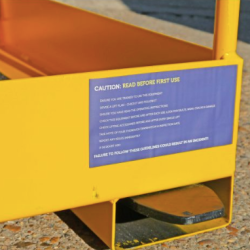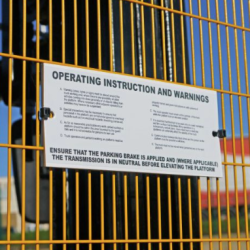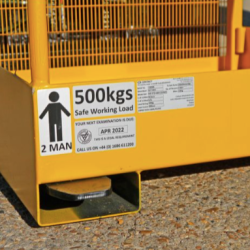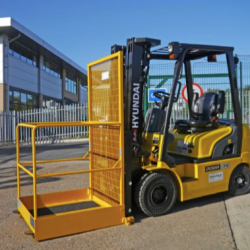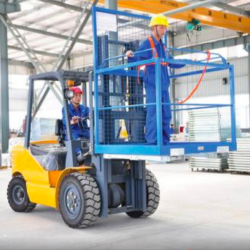Flt Lifting Cages
Thanks for taking the time to view our web site. We only offer training to companies. We don’t offer any training to the public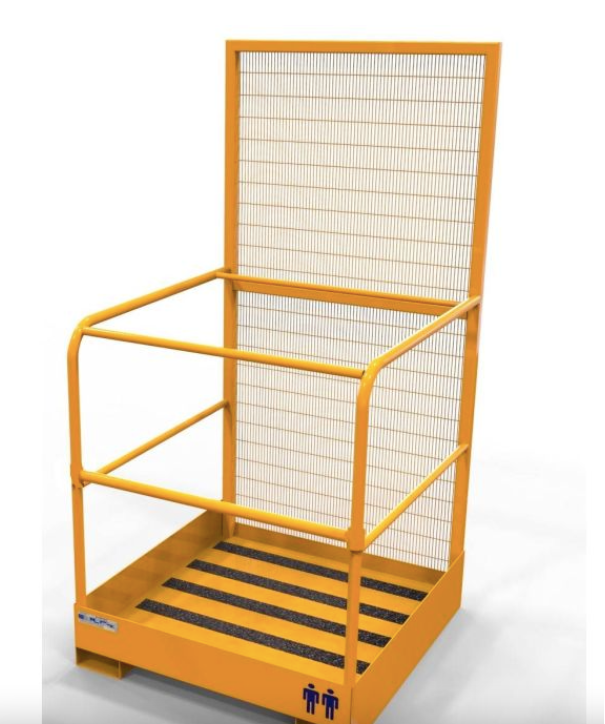
Our team of working at height experts are ready to discuss your specific needs and provide the right solutions – helping you reduce risk, remain compliant and staying safe when working at height.
People say, where there’s a will, there’s a way. When it comes to working at height, this may not necessarily be a good thing. Often, a lack of appropriate access equipment causes employees to find sub-optimal methods of reaching areas at height. This can be dangerous, reckless and is easily avoided.
There is a wide variety of equipment available for work at height, including fixed scaffolding, tower scaffolds, mobile elevating work platforms (MEWPs), portable ladders, as well as non-integrated work platforms, or man-baskets. While the use of the latter is acceptable in very specific circumstances, it is not usually recommended. In this article we will outline what is a non-integrated work platform, how to work safely with it, and when it’s not acceptable to use it as means to access height.
WHEN CAN CAGES BE USED ON LIFT TRUCKS?
According to HSE “Working platforms or ‘cages’ on lift trucks are ‘non-integrated’, ie the lift-truck operator controls the movement of the truck including the cage. There are no controls in the cage to control the truck or cage movement.
The use of non-integrated platforms for planned work is not allowed as there is other purpose-built access equipment, such as the wide variety of mobile elevating work platforms (MEWPs), which are better suited to carrying out work at heights and are safer for the person using the platform. These are readily available for hire.
HSE Guidance Note PM28 ‘Working platforms (non-integrated) on forklift trucks ‘ gives advice on the use of these and clarifies what the law says. It sets out the current standard for use of non-integrated platforms, ie for ‘occasional unplanned use’ only.
PM28 also gives guidance on what ‘occasional unplanned use’ means. It clearly states that non-integrated platforms should only be used for work which is ‘exceptional’. Exceptional work would include unplanned work such as the changing of a single lightbulb as an emergency job. This definition does not include stocktaking or planned maintenance work such as cleaning the light fittings in a factory, window cleaning etc. For jobs like that a mobile elevated work platform (MEWP) with integral controls, such as a scissor lift, should be used.”
What is a non-integrated work platform?
A non-integrated work platform, also known as a forklift cage or a man cage, is an attachment that has been built to be used in a conjunction with a forklift truck to elevate people so that they can complete jobs at height. The elevated person has no control of the platform, and all movements are controlled by the truck operator. It is very different from an integrated attachment for a lift-truck, which provides the person in the basket itself with full control – these integrated solutions are pretty rare, with non-integrated baskets being much more common.
Forklift cages are an easy and handy way to access height if you needed to reach a certain area at your factory and had no other means to do so. However, while they are a very cost-effective solution, they are also the cause of a substantial number of serious accidents. Since trucks are primarily intended for lifting materials, not people, the HSE has put together a guidance note (PM28) which clearly states the occasions upon which the use of non-integrated work platforms is acceptable. Not complying with the HSE guidance leaves organisations vulnerable to safety failures and liable for any accidents.
When is a man-basket NOT the right tool for the job?
According to PM28, any routine or planned tasks such as work associated with production, periodic maintenance or stocktaking are occasions when it is not acceptable to use forklift cages. The reason for this is because non-integrated work platforms don’t provide as many safety features as purpose-built access equipment, and thus they should not be used on regular or planned basis.
Non-integrated work platforms are not suitable for use on:
- Trucks that require manual sequencing of the lift/tilt controls to maintain the horizontal position of the working platform while being lifted.
- Trucks with masts that have erratic movement.
- Trucks that have a capacity of less than 1000kg unless their stability has been verified by testing.
- Variable reach trucks that can lift to a nominal height greater than 6m.
- Pallet stackers with wrap-over type forks.
How to safely work from a forklift cage?
Often people need a temporary means for working at height. Occasional use of non-integrated work platforms is acceptable only in exceptional circumstances i.e. non-routine or urgent tasks for which it is impractical to purchase or hire in purpose-built access equipment, as well as any tasks that would otherwise require the use of less safe means. Some examples of cases when you can use a forklift cage are for clearing a blocked gutter, checking on high-level damage to racking suspected of causing an immediate risk or checking on the condition of damaged roof lights.
There are a few steps to follow if the circumstances do indicate the use of a forklift basket. First and foremost, ensuring a suitable truck, compatible with the basket attachment is used to lift the basket. The best way to do this is to consult with a truck manufacturer or supplier. It is also essential that the platform can be securely attached to the truck, making sure the equipment is stable at all times and people in the platform cannot reach hazardous moving parts or the controls on the truck.
Another very important thing is that the weight of the platform together with it’s load of people, tools, materials and everything else carried in it is not more than half of the actual capacity of the truck. The actual capacity constitutes the capacity of the truck when it’s equipped with any specified attachments and, when carrying out maintenance work, any items that are placed on the platform that add to its overall weight. The user must ensure that the platform is positively locked onto the truck and that the fork arms on the truck extend fully into the fork pockets of the basket attachment.
Steps for the safe use of non-integrated work platforms:
- Attach a sign to the platform that specifies on which trucks it can be used.
- Make sure that all pre-use checks are completed by an authorised person who has received adequate training.
- Ensure that any tilting mechanism, side shift or any variable geometry attachments are not capable of movement when the working platform is elevated.
- Ensure the truck operator is at the controls of the truck at all times when the platform is elevated.
- The truck/working platform combination should only be used on firm, well-maintained and level surfaces.
- There must be adequate communication between the truck operator and people on the work platform.
- There should be an agreed system of hand signals in place that everyone involved is trained in the use of.
- People in the working platform should not stand on the guardrails or lean out of the platform when it is elevated. In cases when people need to lean out of the platform to do work, ensure they wear appropriate personal protective equipment (PPE), which typically consists of a full body harness with lanyard attached to a suitable anchor point.
- Everyone involved in the process from the truck operator to the people in the platform must be properly trained, which includes not only how to operate the equipment, but also knowing what to do in the case of an emergency and the dangers associated with leaning out of the work platform.
- The area below the work at height must be segregated from the normal work activity via the use of warning cones, lights, barriers or signs as appropriate.
- Maintenance is essential and the platform needs to be in good working order, and regularly inspected.
Regulations to be aware of:
- Under the Health and Safety at Work etc Act 1974 employers or people who have control of premises have the duty to ensure the safety of their employees and other people on the premises.
- According to the Management of Health and Safety at Work Regulations 1999 a risk assessment must be carried out before any work at height is done.
- Non-integrated work platforms can only be used under the exception in the Use of Work Equipment Directive (AUWED 89/655/EC amended by 95/63/EC) that allows the use of material handling equipment not designed to lift people in exceptional circumstances.
- When deciding to use a non-integrated or integrated work platform, employers must follow the relevant requirements of the Provision and Use of Work Equipment Regulations 1998 (PUWER).
- The Lifting Operations and Lifting Equipment Regulations 1998 (LOLER) requires that lifting operations are properly planned and work is carried out in a safe manner.
- Under LOLER it’s required that all equipment for lifting people, including trucks and work platforms, are thoroughly examined by a competent person at least every six months.
- All relevant LOLER requirements must be followed for the use of both non-integrated and integrated work platforms.
- Under the Work at Height Regulations 2005 (WAHR) all work at height must be properly planned, organised and the risks controlled.
Non-integrated work platforms do not fall under the Machinery Directive in which a machine is described as “an assembly, fitted with or intended to be fitted with a drive system other than directly applied human or animal effort, consisting of linked parts or components, at least one of which moves, and which are joined together for a specific application.” Therefore, forklift cages must not be CE marked and there is no free movement of their distribution throughout the EU.
To find out more about the rules and regulations when using non-integrated work platforms download the HSE’s Guidance Note PM28 below:
STUDY NOTES | DOCUMENTS
Guidance Notes Working Near Power Lines
FLT Workers Killed
Working Platforms & Cages Study Notes
Flt Work Cage HSE
PUWER 1998
LOLER 1998

